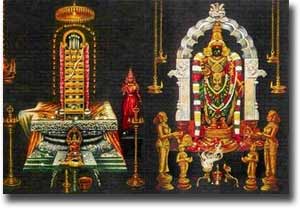 The temple architecture is a treat to the eyes for all those who visit Srikalahasti. A huge white architecture with three lofty gopurams speaks volume for its construction that dates back to Krishnadevaraya and Chola dynasty. Srikalahasti Temple was built by Chola Kings including Todaman Chakravarti. Historically, the temple was constructed in parts by different kings of Chola Dynasty. It is the Chola Dynasty which is credited for renovating and embellishing the temple with intricate sculpture and art. Kulottunga Chola, the great Chola King, contrived and built the beautiful gopurams, located at the entrance facing south, during the 11th century AD. In the late 12th century, Veeranarasimha Yadavaraya festooned the temple with outer Prakaras and four other gopurams connecting four entrances.
The temple architecture is a treat to the eyes for all those who visit Srikalahasti. A huge white architecture with three lofty gopurams speaks volume for its construction that dates back to Krishnadevaraya and Chola dynasty. Srikalahasti Temple was built by Chola Kings including Todaman Chakravarti. Historically, the temple was constructed in parts by different kings of Chola Dynasty. It is the Chola Dynasty which is credited for renovating and embellishing the temple with intricate sculpture and art. Kulottunga Chola, the great Chola King, contrived and built the beautiful gopurams, located at the entrance facing south, during the 11th century AD. In the late 12th century, Veeranarasimha Yadavaraya festooned the temple with outer Prakaras and four other gopurams connecting four entrances.
The Mantapams and Galigopurams facing east were developed by the Vijaynagar rulers in 16th century. Finally, the Natukottai Chettiars of Devakottai gave a final touch to the temple in 1912 by contributing 9 lakhs of rupees.The tower built by Krishnadevaraya in 15th century over the main gate stands at an imposing height of 120 ft. Alongside, the hundred pillared Mantapam (hall inside temple) is another architectural splendour that Srikalahasti is famed for. The Prakara or the compound and four gopurams were built by Veeranarashimha Yadavaraya in 12th Century. The Mantapam or 100 pillared hall was contrived and built by Krishnadevaraya during 1516 AD.
In the centre of the bustling street and bazaars on the sides, Srikalahasti Temple stands elevated with an architecture enwrapped in old world charm. Estimated to be a 1000 and more years old, during a recent repair work, the Shiva temple reflects oodles of culture and antiquity in look. Sculptures of sage Kannappa, Shakti Vinayak and Saivaite bronze figures are quiet old and the exact date of these idols are known till date. Even the lingam of the temple dates back to more than 1000 years. An inside view and study of the pillar and carvings in the temple prove its antiquity beyond 1000 years.
Note: While all the temples are closed during the eclipse, the temple of Srikalahasteesvara is open and special Abhishekams are performed here.The Manikanteswara temple, also in Kalahasti dates back to the period of Raja Raja Chola I (early 11th century), and it was reconstructed in stone in 1196 by Kulottunga III. Shiva here is also referred to as Manikkengauyudaiya Nayanar. There is also a Vishnu shrine in this temple.Bhaktha Kannappa, a hunter is said to have been a great devotee of Kalahasteeswarar. Legend has it that he offered his own eyes to the Shivalingam, and for this reason earned the name Kannappan (his original name being Thinnan), and the distinction of having his statue adorn the sanctum. Nakkiradevar, Indra, Rama, Muchukunda and others are believed to have worshipped Shiva at this temple.
The main Linga, which is in the shape of an elephant trunk, with tusks on each side and a figure of a spider at the bottom, is untouched by human hands, even by the priests. Abhishekam (anointing the Lord) is done to the ‘Utsava Murthi’ by pouring a mixture of water, milk, camphor and Panchamrita. Even sandal paste, flowers and sacred threads are offered to the utsava murthi and not to the main idol. There are some legends and myths associated with the temple of which two are most popular. One of them is in “Sri Kalahasti Satakam”, describing the origin of the name of the temple and the other, in the Tamil hagiology, describing the association of the original jungle temple where Kannappa, an ardent devotee of Lord Shiva worshipped.